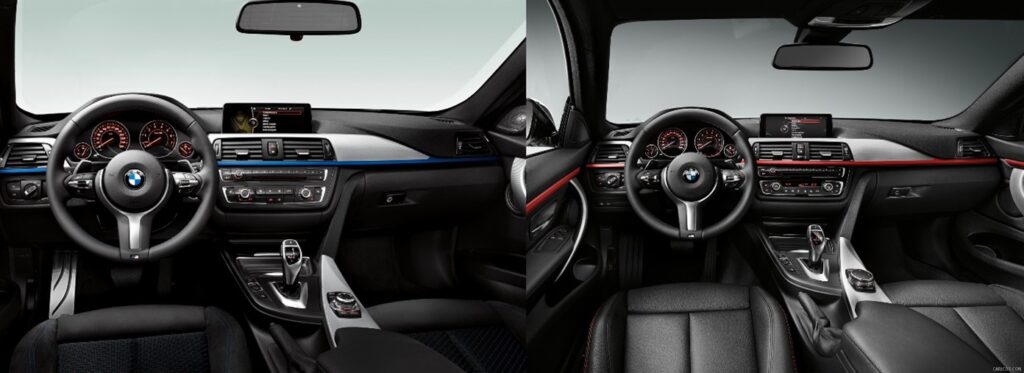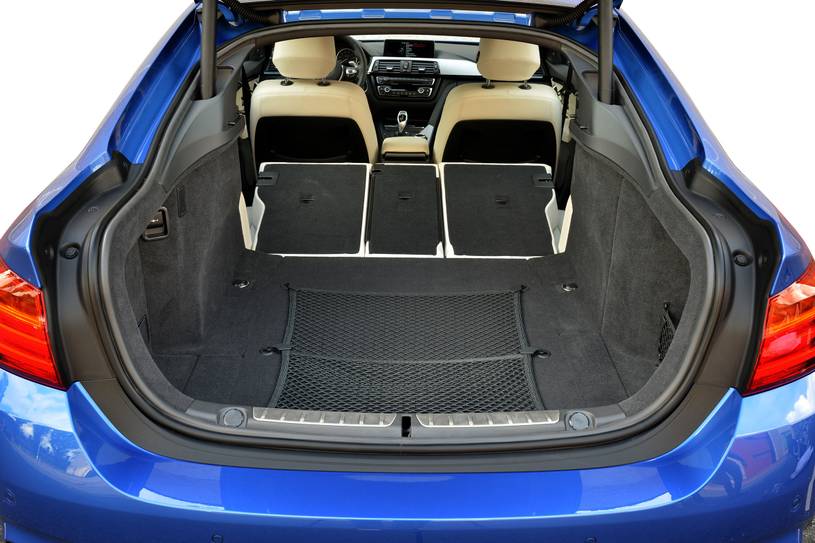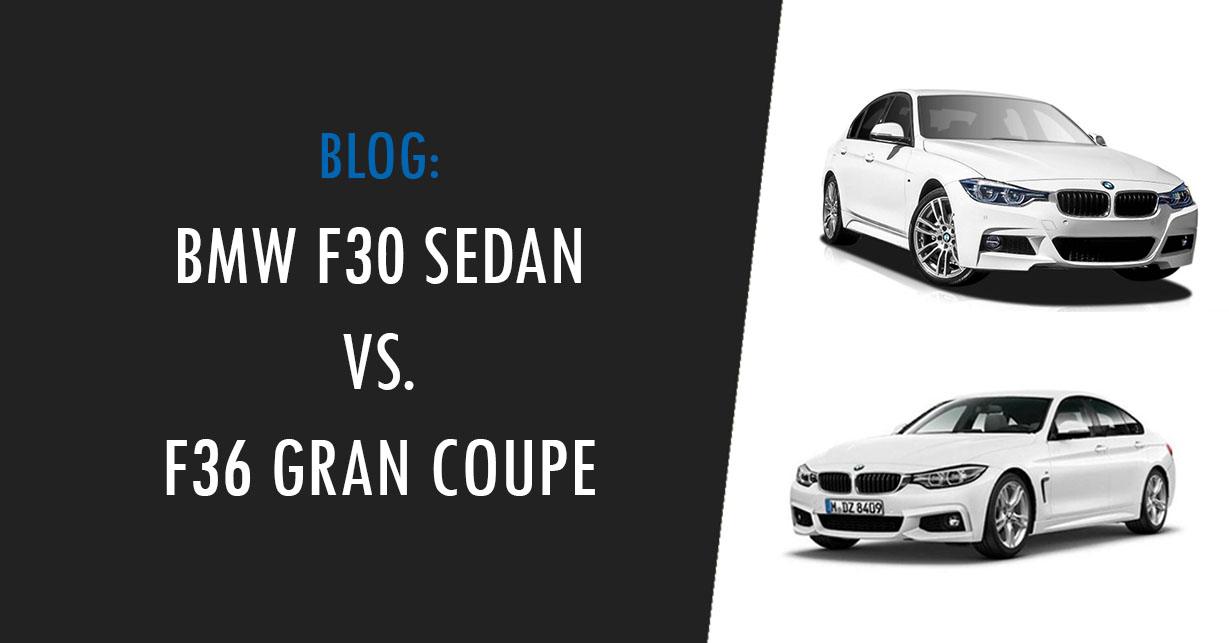BMW offered two medium-sized Sedans for the F-Series generation of cars. The F30 3 Series Sedan and the F36 4 Series Gran Coupe. From the outside, both cars are very similar, but the F36 has a distinctive but discreet low roofline with frameless windows and its curves resemble a 4 Series Coupe.
The F36 is built on the same platform as the F30. This means it shares most of the chassis, suspension, and engine components with the F30. However, its body panels are more similar to a 4 Series coupe. It is lower, wider, and longer which gives it a sleeker appearance.
What are some other differences and similarities? In this article, we’ll compare the BMW F30 Sedan and the BMW F36 Gran Coupe in detail.

F30 vs. F36: Size & Weight
| BMW F30 Sedan | BMW F36 Gran Coupe | |
|---|---|---|
| Wheelbase | 2,810 mm (110.6 in) | 2,810 mm (110.6 in) |
| Length | 4,624 mm (182.0 in) | 4,638 mm (182.6 in) |
| Width | 1,811 mm (71.3 in) | 1,825 mm (71.9 in) |
| Weight | 1,385–1,769 kg (3,053.4–3,900.0 lb) (F30, including hybrid models) | 1,430–1,850 kg (3,153–4,079 lb) |
| Height | 1,429 mm (56.3 in) | 1,377mm (54.2 in) |
As we can see above, the F30 and the F36 share the same wheelbase as they are built on the same platform. The difference lies in the body panels. The F36 is 0.6 inches longer, 0.6 inches wider, almost two inches lower, and it weights around ~200 lbs more than an equivalent F30.
F30 vs. F36: Powertrain
The BMW F36 and the BMW F30 use the same engines, but there are more powertrain options for the F30. The BMW F30 comes in hybrid form with the 330e iPerformance which was a big selling point to those looking for a fuel-efficient hybrid with fully electric capabilities when driving around town.
The F36 was never offered as a hybrid in any market globally. Secondly, the F80 M3 is technically an F30 Sedan which means that you can get a full-fledged BMW F30-based M car while the top-spec BMW F36 is the 440i, and the only way to get a true M car is to go for the 2-door M4 variant.
For both the F30 and the F36 there is a wide range of engines to choose from: you can opt for a fuel-efficient 4-cylinder diesel or one of the powerful inline-6 turbo such as the N55 or B58.
F30 vs. F36: Interior
You’d be hard-pressed to know which one of these two interiors belongs to the F30 because both are essentially identical starting from the front seats and moving forward. Both offer the same dashboard layout, same seats, same steering wheels, and the same overall feeling of space and comfort.
If you’re looking for aftermarket mods for the interior, such as carbon fiber trims, both cars can be equipped with the same interior parts.

The back seats do differ between the F30 and F36. The F36 has 13mm (0.5 in) less rear headroom which can be a dealbreaker for some. The F36 does partly make up for it due to having cool frameless doors. The rear window is also a bit more raked which means that the overall visibility is better with the F30 and the F36 has slightly less shoulder room and isn’t as easy to get in and out of due to smaller rear doors.
Moreover, both have pretty much the same amount of cargo space, but the F36 trunk opens like a hatchback which does make loading cargo a lot easier and is likely the most noticeable practicality difference between the two in the real world. Lastly, the F36 rear power windows don’t open nearly as much as the F30s do which is also a slight drawback of the F36.
F30 vs. F36: Exterior Design
The differences outside are noticeable but discreet. To an unsuspecting eye, they both look the same. When we look at them closer, we see that the F36 shares headlights and taillights with the 4 Series Coupe. The rear quarter panels also resemble a coupe, with a short trunk.
When we open the doors, we see that the F30 has standard doors with frames while all four doors of the F36 are frameless and once again resemble the 4 Series Coupe. Opening the trunk reveals the best feature of the F36: the liftback trunk. The entire back glass lifts in conjunction with the trunk lid and this gives ample space for anything you’d want to get in the car.

The main reason why one would go for an F36 over the F30 is likely the exterior design which looks more special and purposeful. The F30 has always been the best-selling BMW F-Series model globally while the F36 is far behind. This means that seeing an F36 on the street is not as common as seeing an F30. If you want to feel a little bit more special, going for the F36 is the obvious choice.
F30 vs. F36: Optional Equipment Differences
This part of the comparison hasn’t been covered at all when it comes to the BMW F30 and the F36, but it does play a huge role when it comes to finding the right used examples. For starters, the base model F30’s came from the factory with halogen headlights which is a bit disappointing for a 2010s luxury BMW sedan. The F36 on the other hand came with Xenon headlights as standard.
Secondly, BMW didn’t even offer LED Adaptive headlights before the pre-LCI F30 refresh while LED Adaptive lights were available for the pre-LCI F36 as an option. The US market F36 was also offered with a moonroof as standard for all trim levels while the F30 got a moonroof as standard starting from the 340i.
The famed adaptive suspension comes as standard with the F36 while the F30 does offer it as additional equipment. When you put these three together, you are looking at a much better-equipped car from the start. Furthermore, the F36 wasn’t even available without the M-Sport trim in some markets while the F30 always started with the Sport trim.
Finally, we need to point out that the F36 was not available with a manual gearbox for the US market while the F30 was. Depending on your personal preference, this can be either a good thing or a bad thing.
F30 vs. F36: Chassis & Driving
The F30 and the F36 don’t differ all that much when it comes to how they feel behind the wheel, but some differences are noticeable. For example, the F36 is slightly lower to the ground and its roofline is comparably lower. This leads to a lower center of gravity and that alone does improve handling on paper.
On the other hand, the F36 is about 200 pounds heavier on average. This is due to the extra equipment the F36 is equipped with and also the slightly bigger body of the car.
The F36 feels more special to drive, but on paper, the F30 should outperform it due to its lower weight.
F30 Sedan or F36 Gran Coupe: Which one is better?
The winner of this test is the BMW F36 Gran Coupe. Its styling, the practicality of the liftback trunk, and rarity cannot be understated. It also usually comes with better standard equipment and is the more desirable model if you plan to use your car on long road trips or need extra room.
The F30 is also an excellent car, but it just does not feel nearly as special as the F36 does. On the road it’s just another German sedan and it won’t catch your eye as much.
Which one do you prefer?

